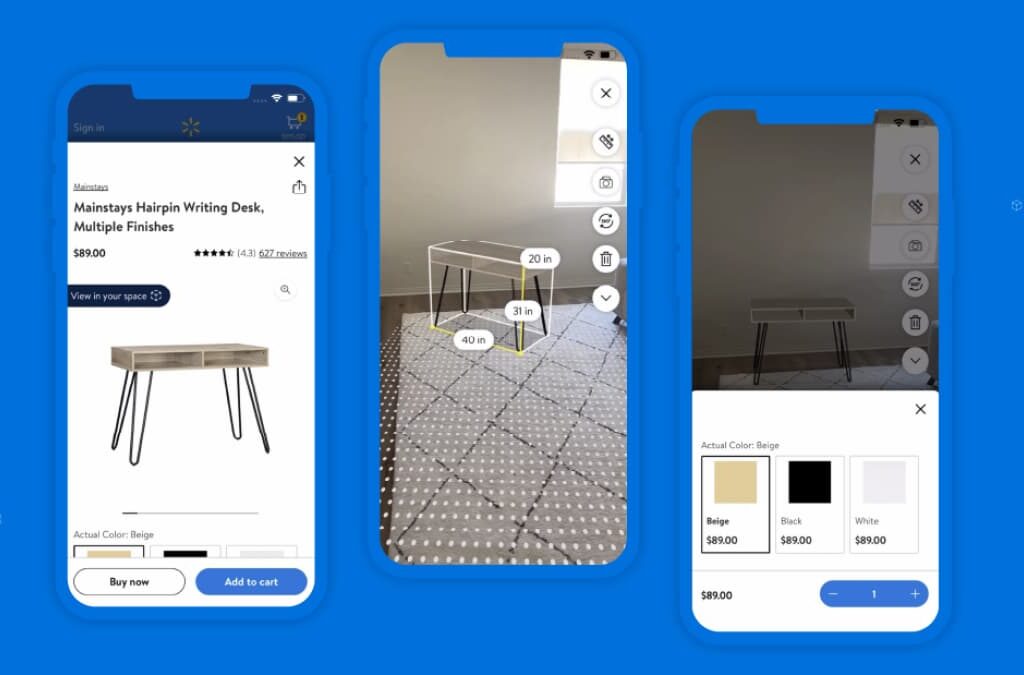Walmart has announced new visual shopping tools meant to give consumers more confidence in their online purchases. It lets them visualize bulky items in AR, such as furniture. The idea is that shoppers can be sure things fit (in style and dimension), which lessens expensive returns among other things.
But before going into the drivers and potential business outcomes, what did Walmart launch, and what’s the user experience like? Known as ‘View in your Home’ the new feature helps consumers virtually position home furnishings and decor in their space to see how it fits and matches their style.
This isn’t a new concept, as AR has proven to be an effective way to get a better sense of product dimensions in one’s space. It has been applied by everyone from Ray-Ban to IKEA, and was further amplified in the Covid era when AR helped bring back the IRL dimension taken away by retail lockdowns.
But through that process, AR was given a chance to shine. That exposure accelerated the adoption curve as consumers developed new shopping habits. Now in a post-Covid world, we continue to see brands and retailers like Walmart jump on AR as a way to give consumers more control and confidence.
Finding Phygital
Going deeper on the new ‘View in Your Home’ feature, it offers haptic feedback, which separates it from many of the other AR shopping features launched to date. The feature makes your smartphone vibrate as you move virtual 3D models up against walls or beyond a given room’s boundaries.
This gives the experience an additional immersive feel, true to the goal of fusing the physical and digital (a.k.a, phygital). Beyond UX, it’s also about providing more functionality and utility in fitting a piece of furniture in one’s room. Haptic feedback joins visual outputs to help consumers get the job done.
To accomplish this requires some advanced room scanning and machine learning. This helps AR apps gain more geometric and semantic understanding. The former is all about sensing the room contours, while the latter is about context. In other words, the app knows that a wall is a wall and a table is a table.
This underlying technology continues to advance with sensors such as LiDAR. Though it’s not ubiquitous in smartphones, it will trickle down over the next few product cycles and gain broader penetration. Other factors continue to democratize advanced room scanning, such as Apple’s Room Plan SDK.
As we examined recently, Room Plan offers computational heavy lifting. That way app developers can pick up and run with the toolset while spending their time instead on the front-end user experience. We should see many more utilitarian apps result – everything from online shopping to DIY renovations.
$550 Billion Headache
Beyond the consumer benefits, AR can help brands and retailers like Walmart in their business objectives. And that brings us back to the drivers for AR implementation. For one, AR visualization has been demonstrated through many brand implementations to boost conversions and basket sizes.
The more informed consumer that AR shopping engenders can also reduce return rates, as noted. This is a major pain point for eTailers as Amazon has set a market standard for free returns. Amazon can take that margin hit but it stings greater for smaller players. Altogether, it’s a $550 billion annual headache.
But the question, as always in Localogy narratives, is what about SMBs? Their adoption curve for AR will be a few years behind, as it often goes. But examining the technology’s advancement and adoption from brands and mid-market players today can be a strong leading indicator for coming SMB standards.
Meanwhile, AR’s use in shopping has been most popular for bulky items, for all the reasons outlined above regarding in-home fit and style. It’s also been popular for anything that goes on one’s face, as the AR visualization is representative of product fit and style – everything from eyewear to cosmetics.
Next up for Walmart is to extend AR to other product categories. This includes large flat-screen TVs. Indeed, visualizing a TV on one’s wall can be a valuable step in the consideration phase of a big and expensive item. Look for AR to continue unlocking other products as Walmart and others double down.




